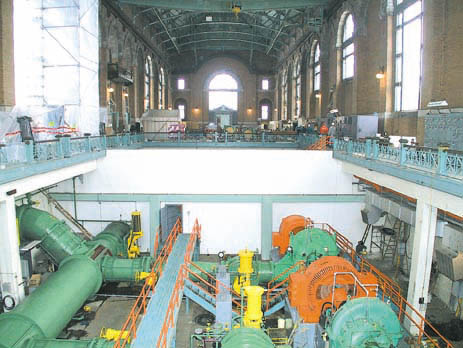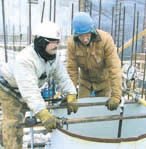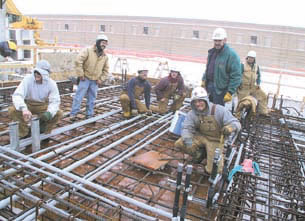Water Works Park II features new technology in an old setting
Date Posted: February 16 2001
Hardhats and a host of contractors are in the process of making a change that will be near and dear to the health and safety of millions of Metro Detroiters - a massive overhaul to the nerve center of the water delivery system.
The building trades, the Detroit Water and Sewer Department and their contractors - dubbed the Detroit Water Team - are in the process of replacing virtually the entire water filtration and pumping systems at Water Works Park on the city's riverfront. The $280 million project will involve the replacement of mechanical systems that date to 1910, and earlier.
"The enormity of the system is really impressive," said Dan Bernard, project manager for the project's mechanical contractor, E.L. Pipe. "I'd love to see how they built this place. They built it over a 30-year period, and it's amazing to see how they did things, and to see the different kinds of pipe and systems in here."
The Water Works II project will involve the replacement of miles of pipe and plumbing systems, but most of that work won't get under way until March or April. Diameters of pipe on the job will range from 120 inches down to three-eighths of an inch. Most of the trades workers currently on site are upgrading electrical systems, and putting in structural iron and re-bar.
"This place is cool as hell," said Doug Hiller, site superintendent for Motor City Electric. "We're virtually building a brand new water treatment plant next door to the existing one. What we're all working for on this whole project will be to throw the switch on the new system and not have the customer lose a drop of water."
Once the new plant is on line, it will run concurrently with the old system for about nine months, and then the old plant will be torn out, Hiller said. The new plant will be able to treat about 320 million gallons per day. Water is expected to be pumped from the new system beginning in November.
The Detroit Water Team consists of five partners, including J.S. Alberici and Walsh Construction, Motor City Electric, and engineering firms Black and Veatch and Montgomery Watson. The project began in early 1999 and the target date for completion of the entire project in April 2002.
One of the largest water treatment plants in the nation, Water Works Park is part of a system that serves about 4 million customers and 127 communities - supplying water to about 43 percent of Michigan residents.
Originally constructed in 1879 on 110 acres on the riverfront, east of Belle Isle, Water Works Park has been revamped over the years and has remained the area's primary water treatment plant.
Around the turn of the century, the park was also a mecca for tourists. The main function of the site was to supply water to metropolitan Detroit, but water commissioners had intended the grounds to be used as a public park as well. At one time, the park included a curving lagoon, where children could wade and navigate small sailboats, tennis courts, a baseball diamond, a picnic area, teeter-totters and swings.
The pumping station at the site probably wasn't very interesting to the general public, but a 185-foot tall brick stand-pipe tower at the site proved to be a tourist attraction. Once called "an architectural exclamation point," this slender minaret-like tower was built to provide an equal pressure for water being pumped into Detroit's water mains. Standing 185 feet tall, this brick structure covered an iron stairway that circled the stand-pipe up the middle that was the business part of the tower. Its usefulness ended in 1893 as new pumping stations came on line to keep up water pressure. But it stayed on as a tourist attraction until it was found to unsafe and unrepairable in 1945, when it was demolished.
The site will return to its role as a public institution, as the renovation will include a science academy and a research center that will serve as the base for a university outreach program and a museum.
When ground was broken on the project, Detroit Water and Sewerage Department director Steve Gorden said customers will get water from a "modern filtration plant at a price seen in the '60s."
The plant will use ozonation to disinfect the raw water pumped in from the Detroit River. Plain air will be passed through an electrical charge, causing the oxygen in the air to turn into ozone, which is an unstable element. Added to the water, the ozone will clean the water and kill bacteria. As a result, the amount of chlorine added to the water can be drastically cut.
The largest building on the site is the Pumping Station No. 2, completed in 1914. Steam-driven pumps were removed long ago, replaced with relatively modern control pumps and motors. The building, which will be retained, has brass fixtures, a marble foyer, beautiful arched windows and character that simply isn't designed into today's buildings.
"This place is amazing," Hiller said. "They'd never justify putting this stuff in a building today."

STEAM-DRIVEN pumps are long-gone from the Detroit Water Works Park Station No. 2, completed in 1914, but new equipment and renovations to the grand old building visible from Jefferson Ave. will play an important role in the upgrade of the mechanical workings of the water system.

AIR PRESSURE testing a 48-inch re-circulation pipe at the Water Works Park plant are Scott Zarembski and Kip Brown of Plumbers 98 and E.L. Pipe.

PLACING CONDUIT amid the re-bar on the new low-lift pump station are a gang of IBEW 58, Motor City electricians, including Robert Hierhozer, John Levering, Scott Housley, Mike Manenti, Kevin Wilks, Doug Hiller, Kraig Kolomyski, Victor Stos and Jason Cape. Two of them aren't pictured.
